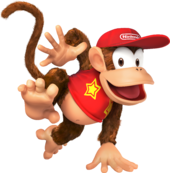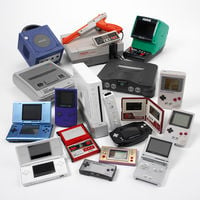Nintendo
- This article is about the Japanese company. For the console sometimes colloquially referred to as a Nintendo, see Nintendo Entertainment System. For the development team, see Nintendo Entertainment Analysis and Development.
| Nintendo | |
|---|---|

| |
| Founded | September 23, 1889 |
| First Super Mario game | Donkey Kong (1981) |
| Latest Super Mario game | Mario + Rabbids Sparks of Hope (2022) |
| Current president | Shuntaro Furukawa |
Nintendo is a video game company with its origins in Japan. Nintendo is the creator of many popular franchises, including the Super Mario franchise, and the company's mascot is Mario himself.
History
Nintendo was originally founded on September 23, 1889, by Fusajiro Yamauchi to produce handmade hanafuda cards for use in Japanese card games. Eventually, in 1929, the company was passed on to Yamauchi's son-in-law, Sekiryo Kaneda. He took up the Yamauchi name when he married Fusajiro's daughter, Tei Yamauchi. Kaneda would run Nintendo until 1949—he passed Nintendo down to his grandson, Hiroshi Yamauchi, before he retired. Under Hiroshi's leadership, Nintendo would dabble in a number of different businesses before sticking primarily to games. Nintendo entered the arcade industry in the 1970s, and it began to license some of its games to other companies for distribution outside Japan. Nintendo eventually set up its own headquarters in the United States headed by Minoru Arakawa, and the first game that would be distributed by the American division would be Radar Scope}. Radar Scope did not sell well in the United States, and a number of unsold cabinets remained in warehouses.
Arakawa asked Hiroshi if a new game could be developed and inserted into the unsold Radar Scope cabinets.[1] Hiroshi went through Nintendo's entire talent pool to see who could head the designing of a potential Radar Scope replacement, and the result was Shigeru Miyamoto designing Donkey Kong. When Donkey Kong was released, it became a bestseller. Around this time, Nintendo assigned Gunpei Yokoi to make a handheld console for enjoyment while traveling. Thus, Yokoi made the Game & Watch, which became popular in both Japan and the United States. Nintendo then made the Nintendo Entertainment System; its success resulted in Nintendo becoming a dominant player in the video game industry and the revival of the industry in North America, which had been negatively affected by a crash in 1983. The most successful game for the NES, Super Mario Bros., further cemented Nintendo's dominance in the industry. Aside from video games, Nintendo was also the majority owner of the Seattle Mariners, a Major League Baseball team from 1992 to 2016. In 2002, Hiroshi Yamauchi stepped down from office, giving the position to Satoru Iwata, who later became CEO of Nintendo's American branch and held both posts until his death in July 2015. Afterwards, Tatsumi Kimishima was appointed Iwata's successor in September 2015, until he stepped down on June 28, 2018, and was succeeded by Shuntaro Furukawa.
Appearances in the Super Mario universe
- The WarioWare character 9-Volt calls himself "Nintendo's biggest fanboy," and his microgames are based on or around various Nintendo games and systems such as Dr. Mario and Donkey Kong.
- Diddy Kong's red cap has the Nintendo logo on it.
- Nintendo sponsors can be seen in the background of various Mario Kart courses and battle arenas.
- In the Mario Party series, the Nintendo logo, along with the Hudson Soft logo, appears on banners in various minigames.
- In Donkey Kong 64, Nintendo, along with Rareware, sponsors the boxing match between the Kongs and King K. Rool as mentioned by the Microphone.
- In Mario Power Tennis, the Nintendo logo appears on the Peach Dome court.
- In Mario Golf: Toadstool Tour and Mario Power Tennis, Wario holds up the Nintendo sign when the game boots up while stating the company's name, laughing.
- In Mario Hoops 3-on-3, the Nintendo logo, along with the Square Enix logo, appears on the arch next to the basket at Peach Field and on the banner and a large screen on the Mario Stadium court.
- In the Mario Baseball series, the Nintendo logo appears on some signs in Mario Stadium.
- In Mario Sports Mix, the Nintendo logo appears next to the sports equipment on the banners in Mario Stadium.
- In Mario Tennis Open, the Nintendo logo can be seen on the scoreboards in various courts.
Home consoles
- Color TV-Game series (1977–1982)
- Family Computer (1983–2003) / Nintendo Entertainment System (1985–1995)
- Super Famicom (1990–2003) / Super Nintendo Entertainment System (1991–1999)
- Nintendo 64 (1996–2003)
- Nintendo GameCube (2001–2009)
- Wii (2006–2013)
- Wii U (2012–2017)
- Nintendo Switch1 (2017–present)
Attachments and remodels
- Family Computer Disk System (1986–1994)
- Satellaview (1995–2000)
- Nintendo 64DD (1999–2001)
- Wii Family Edition (2011–2013)
- Wii mini (2012–2017)
These consoles may have different names in different markets. The NES is known as Famicom in Japan; the SNES, subsequently as Super Famicom. In China, the Nintendo 64 was released under the name iQue Player.
1 - Although the Nintendo Switch can also function as a handheld console, it is primarily marketed as a home console by Nintendo.
Handheld consoles
- Game & Watch (1980–1991)
- Game Boy (1989–2003)
- Virtual Boy (1995–1996)
- Game Boy Color (1998–2003)
- Game Boy Advance (2001–2009)
- Nintendo DS (2004–2013)
- Nintendo 3DS (2011–2019)
Remodels
- Game Boy Play it Loud (1996)
- Game Boy Pocket (1996–1998)
- Game Boy Light (1997–2003)
- Game Boy Advance SP (2003–2009)
- Game Boy Micro (2005–2009)
- Nintendo DS Lite (2006–2011)
- Nintendo DSi (2008–2013)
- Nintendo DSi XL (2009–2013)
- Nintendo 3DS XL (2012–2015)
- Nintendo 2DS (2013–2020)
- New Nintendo 3DS (2014–2017)
- New Nintendo 3DS XL (2014–2019)
- New Nintendo 2DS XL (2017–2020)
- Nintendo Switch Lite (2019–present)
Releases of these consoles in China usually replace "Nintendo" in the name with "iQue." Examples are the iQue DS and the iQue 3DS XL.
Gallery
The gold Nintendo logo from the start-up of Mario Kart 64
Sprite of a Nintendo logo variant, from Diddy Kong Racing DS
The white Nintendo logo in a black background as seen in the first three Mario Party titles
The Nintendo logo recreated in the Super Mario Bros. game style in Super Mario Maker
Background featuring Super Mario characters created by Nintendo
Artwork of Nintendo's Kyoto headquarters from its recruitment book, showing a Warp Pipe at the bottom-left corner
See also
- Shigeru Miyamoto
- Satoru Iwata
- Hiroshi Yamauchi
- Yoshiaki Koizumi
- Tatsumi Kimishima
- Koji Kondo
- Gunpei Yokoi
- Reggie Fils-Aimé
- Doug Bowser
Names in other languages
| Language | Name | Meaning |
|---|---|---|
| Japanese | 任天堂 ニンテンドー ニンテンドウ Nintendō |
任天堂 is the formal name of the company; in hiragana and furigana form, it is written as にんてんどう. Each of the kanji that make up its formal name mean the following:
ニンテンドー is a rough katakana form is used for the Japanese names of some consoles. This name comes from the Japanese saying 「運を天に任せる」(un o ten ni makaseru), meaning "To leave one's luck to heaven." |
| Chinese | 任天堂 Rèntiāntáng |
- |
| Finnish | Nintendon (Captain N: The Game Master) Nintendo |
- - |
| Greek | Νιντέντο Ninténto |
- |
| Hebrew | נינטנדו Nyntndv |
- |
| Korean | 닌텐도 Nintendo |
- |
| Russian | Нинтендо Nintendo |
- |
External links
- Official Japanese website
- Official American website
- Official Canadian (English) website
- Official Canadian (French) website
- Official Latin American website
- Official Brazilian website
- Official Colombian website
- Official Argentinian website
- Official Chilean website
- Official Peruvian website
- Official European website
- Official Danish website
- Official Finnish website
- Official Norwegian website
- Official Swedish website
- Official Hungarian website
- Official Polish website
- Official Czech website
- Official Slovak website
- Official Israeli website
- Official Oceanian website
- Official Korean website
- Official Hong Kongese (Traditional) website
- Official Hong Kongese (Simplified) website
- Official Taiwanese website
- Official Singaporean website
- Official Malay website
- Official Filipino website
- Official Thai website
- Official Mainland Chinese website




